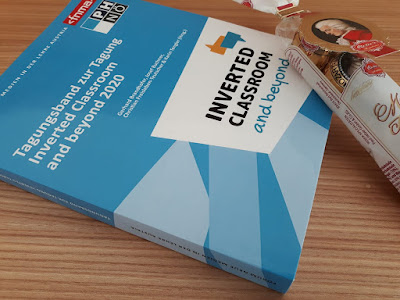Inverted Classroom and Beyond 2020 conference proceedings
It was an honor to be a keynote speaker this week at the Inverted Classroom and Beyond 2020 -conference in Austria. I thank the committee for the possibility to write an article to the conference proceedings Tagungsband zur Tagung Inverted Classroom and beyond 2020. In my presentation, I wanted to direct attention towards the support teachers need when they start to flip. Not only theoretical and practical support are needed but also emotional support.
What hampers the reforming of schools and teaching is the fact that the traditional teaching is considered to be the most deeply ingrained and valuable of the approaches to teaching. It is as if the traditional teaching should be learned before one can even start trying anything else. The problem is significant, because experimentation is limited when one declares traditional teaching to be more valuable or more effective than other forms of teaching. This more likely means a quick return to the traditional teaching even after minor setbacks.
In my training, there is often someone in the audience who states, “In one class, the flipped classroom was really successful, but not in another. In fact, in that other case it didn’t work at all, so I was forced to return to traditional teaching.” In these situations, going back to the old style does not mean that students would learn better. Rather, it means returning to a baseline that no one needs to justify. It also means to get rid of the forces which might have developed into a storm around the teacher. There is a risk for flipped learning teacher to burn-out not only for the amount of work at the beginning but also because of depression caused by the opposition.
The truth is that a teacher cannot create a learning culture of flipped learning alone. Students either help or hinder the teacher in his of her work. The role of the teacher is challenging and complex. There is no one way to do things “right”. The only sure thing is that teachers must always have the ability to look at their students and react to what they see. In flipped learning, learning is approached from the point of view of an individual student. Understanding the significance of the word approached is key: the teacher’s primary goal is to learn to approach learning through the eyes of the student and to help the student become a teacher for him or herself.
Here is the link to my article. For those of you who understand German here is the link to the whole conference proceedings.
This text is first published in my other blogs www.flippedassessment.com.
What hampers the reforming of schools and teaching is the fact that the traditional teaching is considered to be the most deeply ingrained and valuable of the approaches to teaching. It is as if the traditional teaching should be learned before one can even start trying anything else. The problem is significant, because experimentation is limited when one declares traditional teaching to be more valuable or more effective than other forms of teaching. This more likely means a quick return to the traditional teaching even after minor setbacks.
In my training, there is often someone in the audience who states, “In one class, the flipped classroom was really successful, but not in another. In fact, in that other case it didn’t work at all, so I was forced to return to traditional teaching.” In these situations, going back to the old style does not mean that students would learn better. Rather, it means returning to a baseline that no one needs to justify. It also means to get rid of the forces which might have developed into a storm around the teacher. There is a risk for flipped learning teacher to burn-out not only for the amount of work at the beginning but also because of depression caused by the opposition.
The truth is that a teacher cannot create a learning culture of flipped learning alone. Students either help or hinder the teacher in his of her work. The role of the teacher is challenging and complex. There is no one way to do things “right”. The only sure thing is that teachers must always have the ability to look at their students and react to what they see. In flipped learning, learning is approached from the point of view of an individual student. Understanding the significance of the word approached is key: the teacher’s primary goal is to learn to approach learning through the eyes of the student and to help the student become a teacher for him or herself.
Here is the link to my article. For those of you who understand German here is the link to the whole conference proceedings.
This text is first published in my other blogs www.flippedassessment.com.



